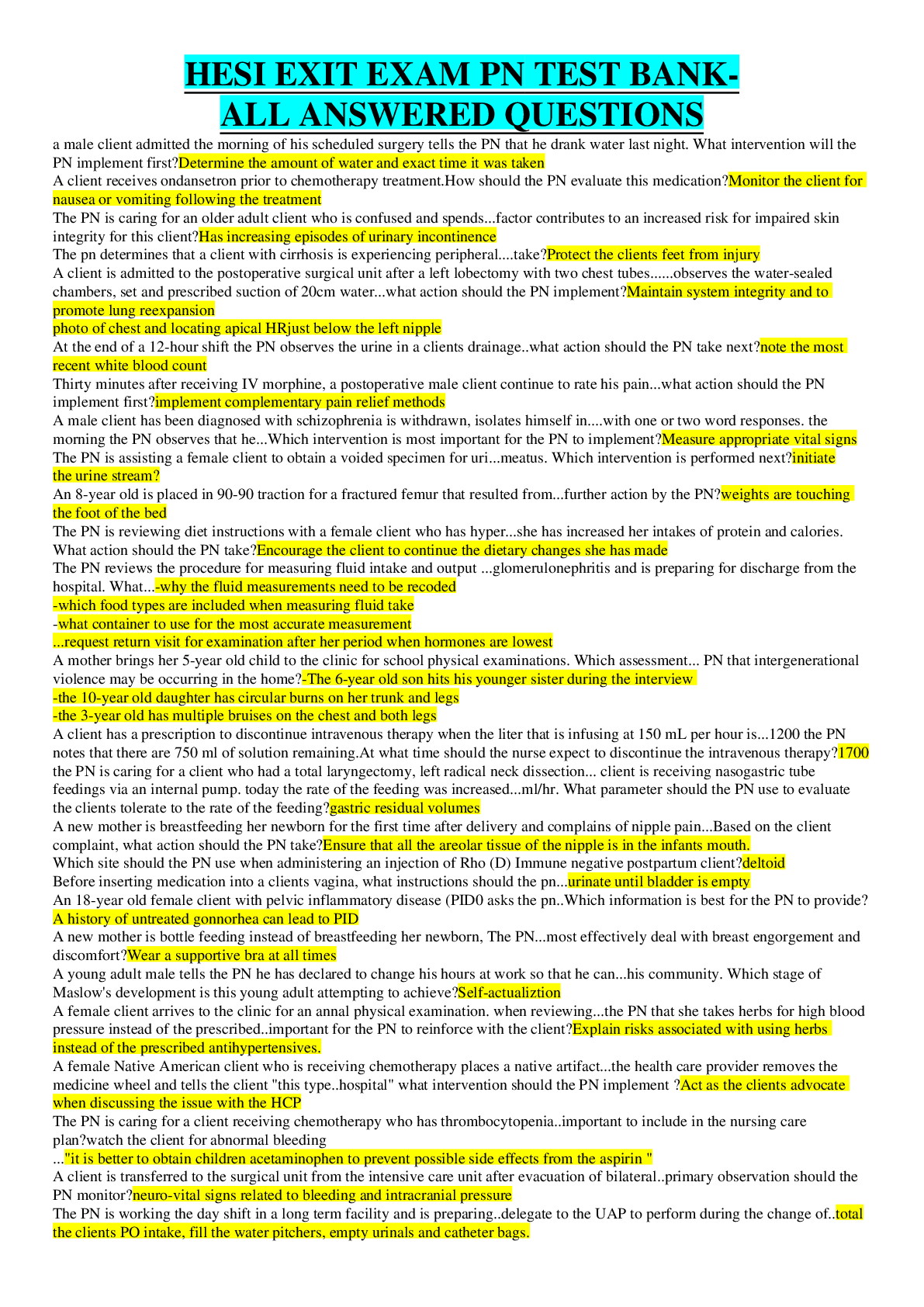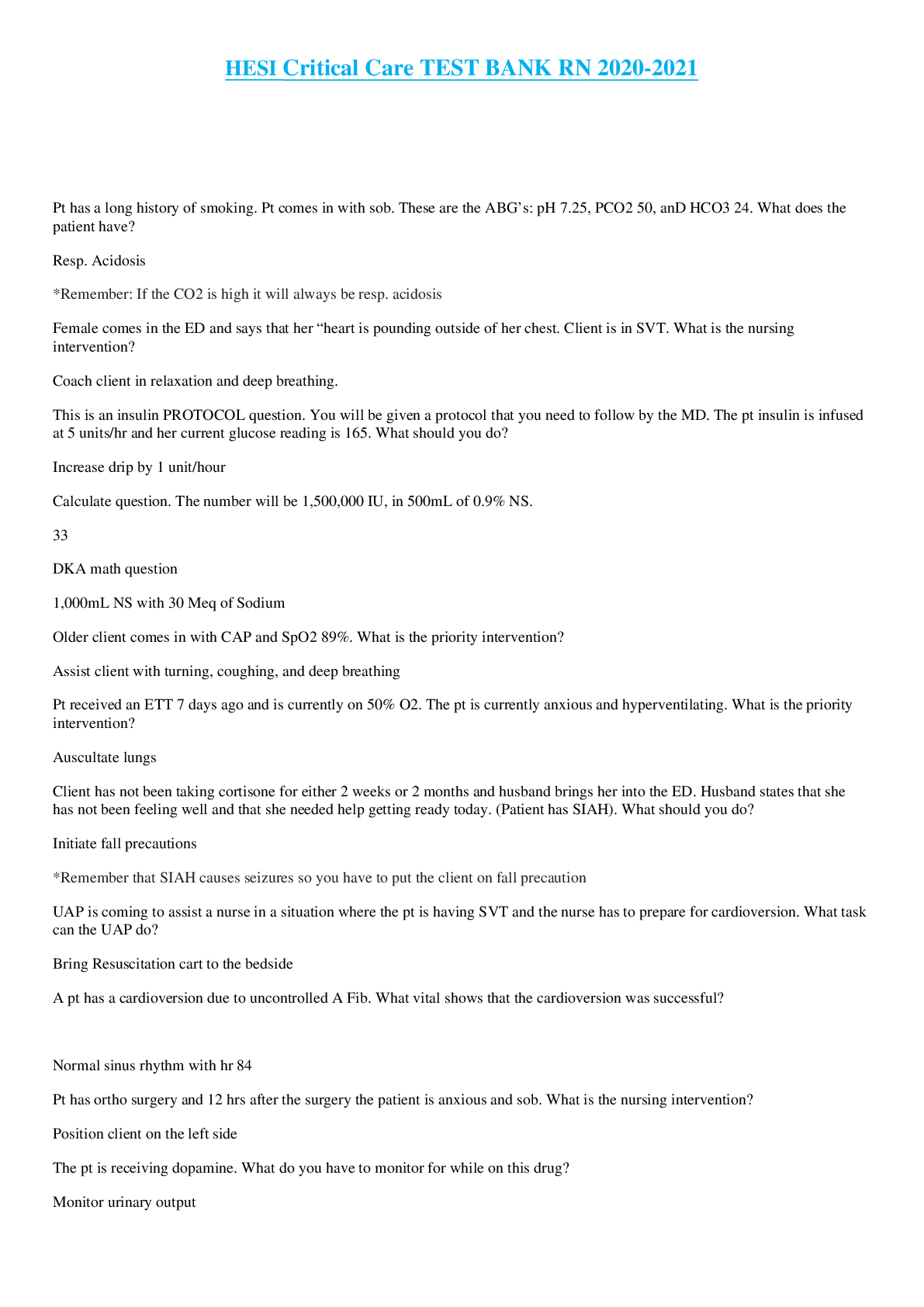265 Morsels of Exit HESI Goodness
Document Content and Description Below
265 Morsels of Exit HESI Goodness 1.ID: 9476788675 Enalapril maleate is prescribed for a hospitalized client. Which assessment does the nurse perform as a priority before administering the medicat... ion? A. Checking the client's blood pressure Correct B. Checking the client's peripheral pulses C. Checking the most recent potassium level D. Checking the client's intake-and-output record for the last 24 hours Incorrect Rationale: Enalapril maleate is an angiotensin-converting enzyme (ACE) inhibitor used to treat hypertension. One common side effect is postural hypotension. Therefore the nurse would check the client’s blood pressure immediately before administering each dose. Checking the client’s peripheral pulses, the results of the most recent potassium level, and the intake and output for the previous 24 hours are not specifically associated with this mediation. Test-Taking Strategy: Focus on the name of the medication and recall that medications that end in the letters “pril” are ACE inhibitors and that these medications are used to treat hypertension. This will direct you to the correct option. Review the action of enalapril maleate if you had difficulty with this question. Reference: Lehne, R. (2013). Pharmacology for nursing care (8th ed., p. 513). St. Louis: Saunders. Cognitive Ability: Analyzing Client Needs: Physiological Integrity Integrated Process: Nursing Process/Assessment Content Area: Pharmacology Giddens Concepts: Care Coordination, Safety HESI Concepts:Collaboration/Managing Care, Safety Awarded 0.0 points out of 1.0 possible points. 2.ID: 9476754035 A client is scheduled to undergo an upper gastrointestinal (GI) series, and the nurse provides instructions to the client about the test. Which statement by the client indicates a need for further instruction? A. "The test will take about 30 minutes." B. "I need to fast for 8 hours before the test." Incorrect C. "I need to drink citrate of magnesia the night before the test and give myself a Fleet enema on the morning of the test." Correct D. "I need to take a laxative after the test is completed, because the liquid that I’ll have to drink for the test can be constipating." Rationale: An upper GI series involves visualization of the esophagus, duodenum, and upper jejunum by means of the use of a contrast medium. It involves swallowing a contrast medium (usually barium), which is administered in a flavored milkshake. Films are taken at intervals during the test, which takes about 30 minutes. No special preparation is necessary before a GI series, except that NPO status must be maintained for 8 hours before the test. After an upper GI series, the client is prescribed a laxative to hasten elimination of the barium. Barium that remains in the colon may become hard and difficult to expel, leading to fecal impaction. Test-Taking Strategy: Use the process of elimination. Note the strategic words "need for further instruction." These words indicate a negative event query and the need to select the incorrect client statement. Focusing on the word "upper" in the name of the test will direct you to the correct option. Review preprocedure care for an upper GI series if you had difficulty with this question. Reference: Lewis, S., Dirksen, S., Heitkemper, M., & Bucher, L. (2014). Medical-surgical nursing: Assessment and management of clinical problems (9th ed., p. 879). St. Louis: Mosby. Cognitive Ability: Evaluating Client Needs: Physiological Integrity Integrated Process: Teaching and Learning Content Area: Adult Health/Gastrointestinal Giddens Concepts: Client Education, Clinical Judgment HESI Concepts:Clinical Decision Making/Clinical Judgment, Teaching and Learning/Patient Education Awarded 0.0 points out of 1.0 possible points. 3.ID: 9476790957 A nurse on the evening shift checks a health care provider's prescriptions and notes that the dose of a prescribed medication is higher than the normal dose. The nurse calls the health care provider's answering service and is told that the health care provider is off for the night and will be available in the morning. The nurse should: A. Call the nursing supervisor B. Ask the answering service to contact the on-call health care provider Correct C. Withhold the medication until the health care provider can be reached in the morning D. Administer the medication but consult the health care provider when he becomes available Rationale: The nurse has a duty to protect the client from harm. A nurse who believes that a health care provider’s prescription may be in error is responsible for clarifying the prescription before carrying it out. Therefore the nurse would not administer the medication; instead, the nurse would withhold the medication until the dose can be clarified. The nurse would not wait until the next morning to obtain clarification. It is premature to call the nursing supervisor. Test-Taking Strategy: Use the process of elimination and your knowledge of the legal responsibilities of the nurse in regard to medication administration and health care provider’s prescriptions. Eliminate the options that are comparable or alike in that they avoid clarification of the prescription (administering the medication and holding the medication). To select from the remaining options, note that it is premature to call the nursing supervisor. Also note that the correct option is the only one that clarifies the prescription. Review legal responsibilities in regard to medication prescriptions if you had difficulty with this question. Reference: Potter, P., Perry, A. G., Stockert, P. A., & Hall, A. M. (2013). Fundamentals of nursing. (8th ed., p.585). St. Louis: Mosby. Cognitive Ability: Applying Client Needs: Safe and Effective Care Environment Integrated Process: Nursing Process/Implementation Content Area: Leadership and Management Giddens Concepts: Clinical Judgment, Leadership HESI Concepts:Collaboration/Managing Care, Clinical Decision Making/Clinical Judgment Awarded 1.0 points out of 1.0 possible points. 4.ID: 9476788615 An emergency department (ED) nurse is monitoring a client with suspected acute myocardial infarction (MI) who is awaiting transfer to the coronary intensive care unit. The nurse notes the sudden onset of premature ventricular contractions (PVCs) on the monitor, checks the client's carotid pulse, and determines that the PVCs are not resulting in perfusion. The appropriate action by the nurse is: A. Documenting the findings B. Asking the ED health care provider to check the client Correct C. Continuing to monitor the client's cardiac status D. Informing the client that PVCs are expected after an MI Rationale: PVCs are a result of increased irritability of ventricular cells. Peripheral pulses may be absent or diminished with the PVCs themselves because the decreased stroke volume of the premature beats may in turn decrease peripheral perfusion. Because other rhythms also cause widened QRS complexes, it is essential that the nurse determine whether the premature beats are resulting in perfusion of the extremities. This is done by palpating the carotid, brachial, or femoral artery while observing the monitor for widened complexes or by auscultating for apical heart sounds. In the situation of acute MI, PVCs may be considered warning dysrhythmias, possibly heralding the onset of ventricular tachycardia or ventricular fibrillation. Therefore the nurse would not tell the client that the PVCs are expected. Although the nurse will continue to monitor the client and document the findings, these are not the most appropriate actions of those provided. The most appropriate action would be to ask the ED health care provider to check the client. Test-Taking Strategy: Use the process of elimination. Recalling the significance of PVCs after acute MI and noting the strategic words "not perfusing" will direct you to the correct option. Review the significance of PVCs after acute MI if you had difficulty with this question. Reference: Lewis, S., Dirksen, S., Heitkemper, M., & Bucher, L. (2014). Medical-surgical nursing: Assessment and management of clinical problems (9th ed., p. 799). St. Louis: Mosby. Cognitive Ability: Applying Client Needs: Physiological Integrity Integrated Process: Nursing Process/Implementation Content Area: Critical Care Giddens Concepts: Clinical Judgment, Perfusion HESI Concepts: Clinical Decision Making/Clinical Judgment, Perfusion Awarded 1.0 points out of 1.0 possible points. 5.ID: 9476763527 NPO status is imposed 8 hours before the procedure on a client scheduled to undergo electroconvulsive therapy (ECT) at 1 p.m. On the morning of the procedure, the nurse checks the client's record and notes that the client routinely takes an oral antihypertensive medication each morning. The nurse should: A. Administer the antihypertensive with a small sip of water Correct B. Withhold the antihypertensive and administer it at bedtime C. Administer the medication by way of the intravenous (IV) route Incorrect D. Hold the antihypertensive and resume its administration on the day after the ECT Rationale: General anesthesia is required for ECT, so NPO status is imposed for 6 to 8 hours before treatment to help prevent aspiration. Exceptions include clients who routinely receive cardiac medications, antihypertensive agents, or histamine (H2) blockers, which should be administered several hours before treatment with a small sip of water. Withholding the antihypertensive and administering it at bedtime and withholding the antihypertensive and resuming administration on the day after the ECT are incorrect actions, because antihypertensives must be administered on time; otherwise, the risk for rebound hypertension exists. The nurse would not administer a medication by way of a route that has not been prescribed. Test-Taking Strategy: Use the process of elimination. Use your knowledge of the principles of medication administration to help eliminate the option that involves administering the medication by way of a route other than the prescribed one. Recalling that antihypertensives must be administered on a regular schedule will assist you in eliminating the options that involve withholding the medication. Review preprocedure care for the client scheduled for ECT if you had difficulty with this question. Reference: Stuart, G. (2013). Principles & practice of psychiatric nursing (10th ed.,p. 597). St. Louis: Mosby. Cognitive Ability: Applying Client Needs: Physiological Integrity Integrated Process: Nursing Process/Implementation Content Area: Mental Health Giddens Concepts: Clinical Judgment, Safety HESI Concepts: Clinical Decision Making/Clinical Judgment, Safety Awarded 0.0 points out of 1.0 possible points. 6.ID: 9476755914 A client who recently underwent coronary artery bypass graft surgery comes to the health care provider's office for a follow-up visit. On assessment, the client tells the nurse that he is feeling depressed. Which response by the nurse is therapeutic? A. "Tell me more about what you’re feeling." Correct B. "That’s a normal response after this type of surgery." C. "It will take time, but, I promise you, you will get over this depression." D. "Every client who has this surgery feels the same way for about a month." Rationale: When a client expresses feelings of depression, it is extremely important for the nurse to further explore these feelings with the client. In stating, "This is a normal response after this type of surgery" the nurse provides false reassurance and avoids addressing the client’s feelings. "It will take time, but, I promise you, you will get over the depression" is also a false reassurance, and it does not encourage the expression of feelings. "Every client who has this surgery feels the same way for about a month" is a generalization that avoids the client’s feelings. Test-Taking Strategy: Use your knowledge of therapeutic communication techniques. Eliminate the options that are nontherapeutic and do not encourage the client to express feelings. Remember to always focus on the client’s feelings. Review therapeutic communication techniques if you had difficulty with this question. Reference: Ignatavicius, D., & Workman, M. (2013). Medical-surgical nursing: Patient-centered collaborative care. (7th ed., p.841). St. Louis: Saunders. Cognitive Ability: Applying Client Needs: Psychosocial Integrity Integrated Process: Communication and Documentation Content Area: Adult Health/Cardiovascular Giddens Concepts: Communication, Mood and Affect HESI Concepts: Communication, Mood and Affect ...........continued [Show More]
Last updated: 1 year ago
Preview 1 out of 83 pages

Reviews( 0 )
Document information
Connected school, study & course
About the document
Uploaded On
Jan 29, 2021
Number of pages
83
Written in
Additional information
This document has been written for:
Uploaded
Jan 29, 2021
Downloads
0
Views
38

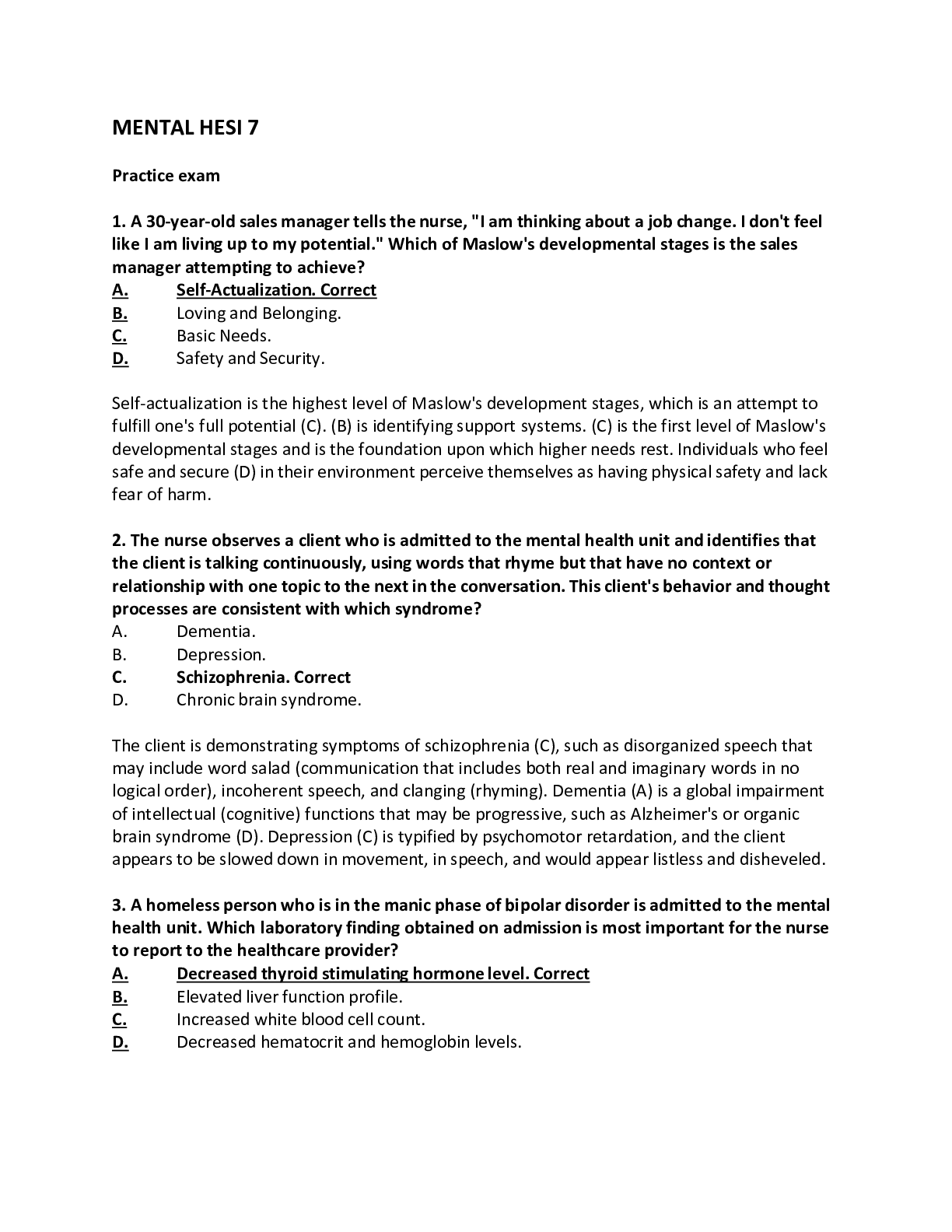
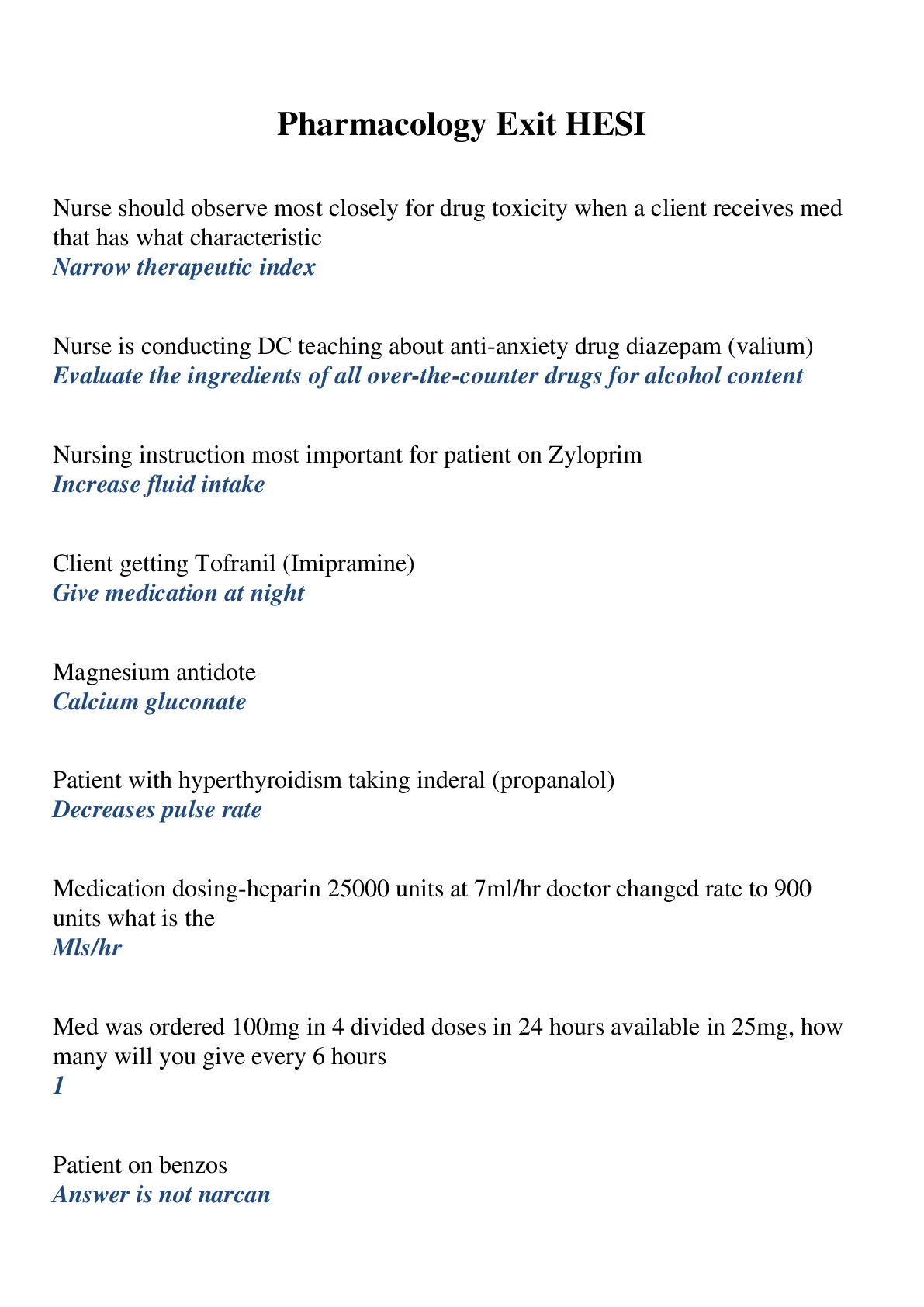
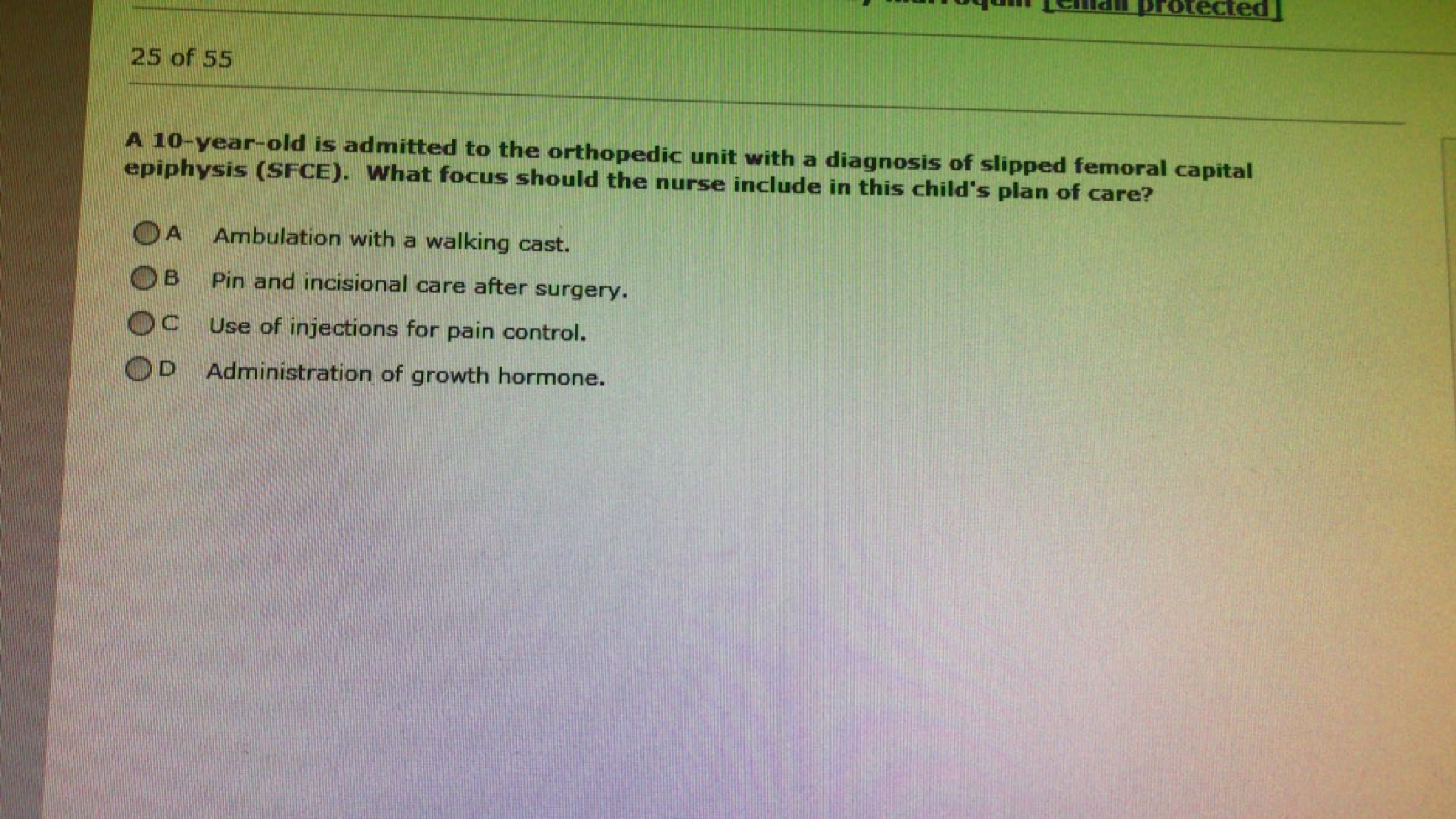
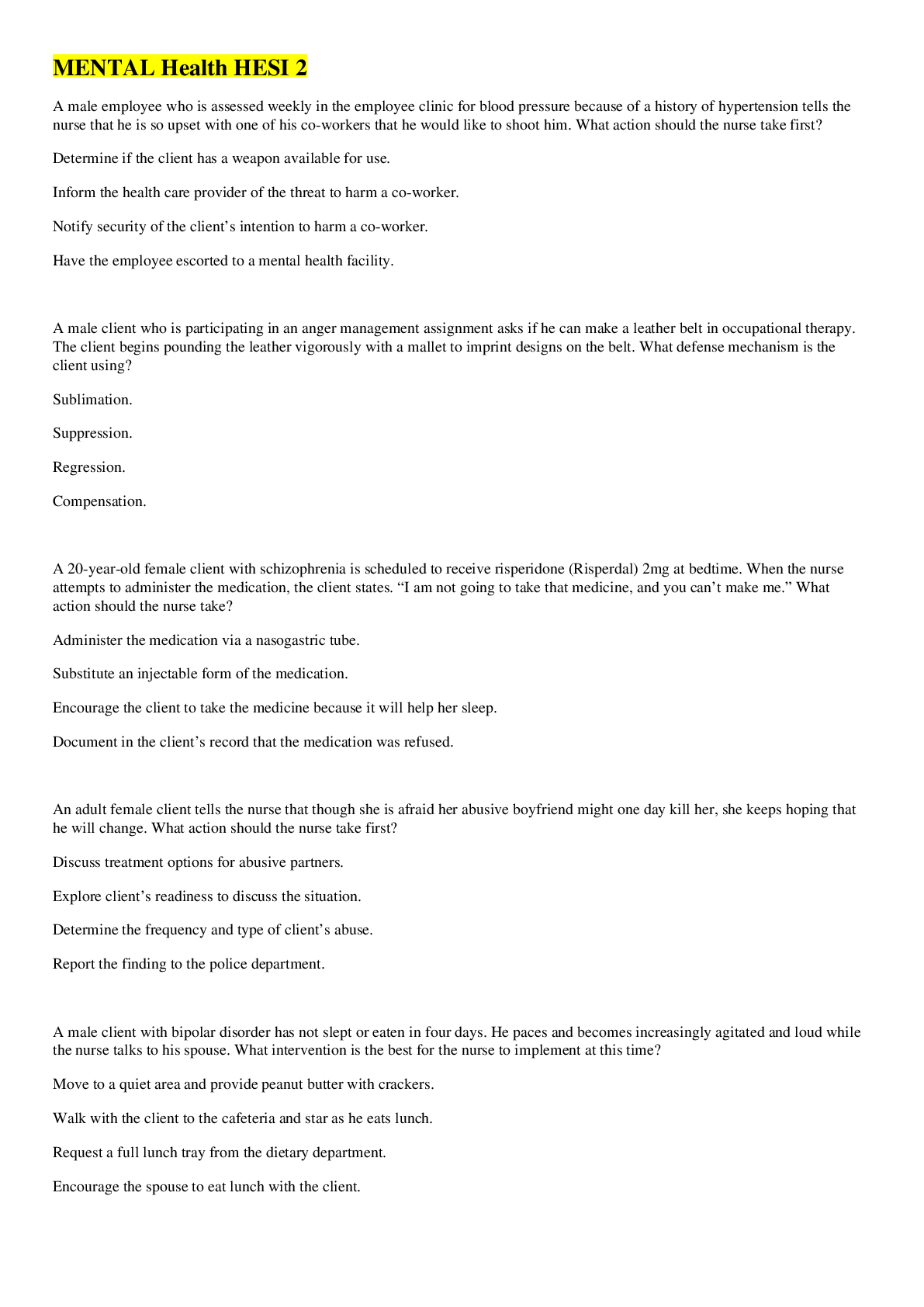
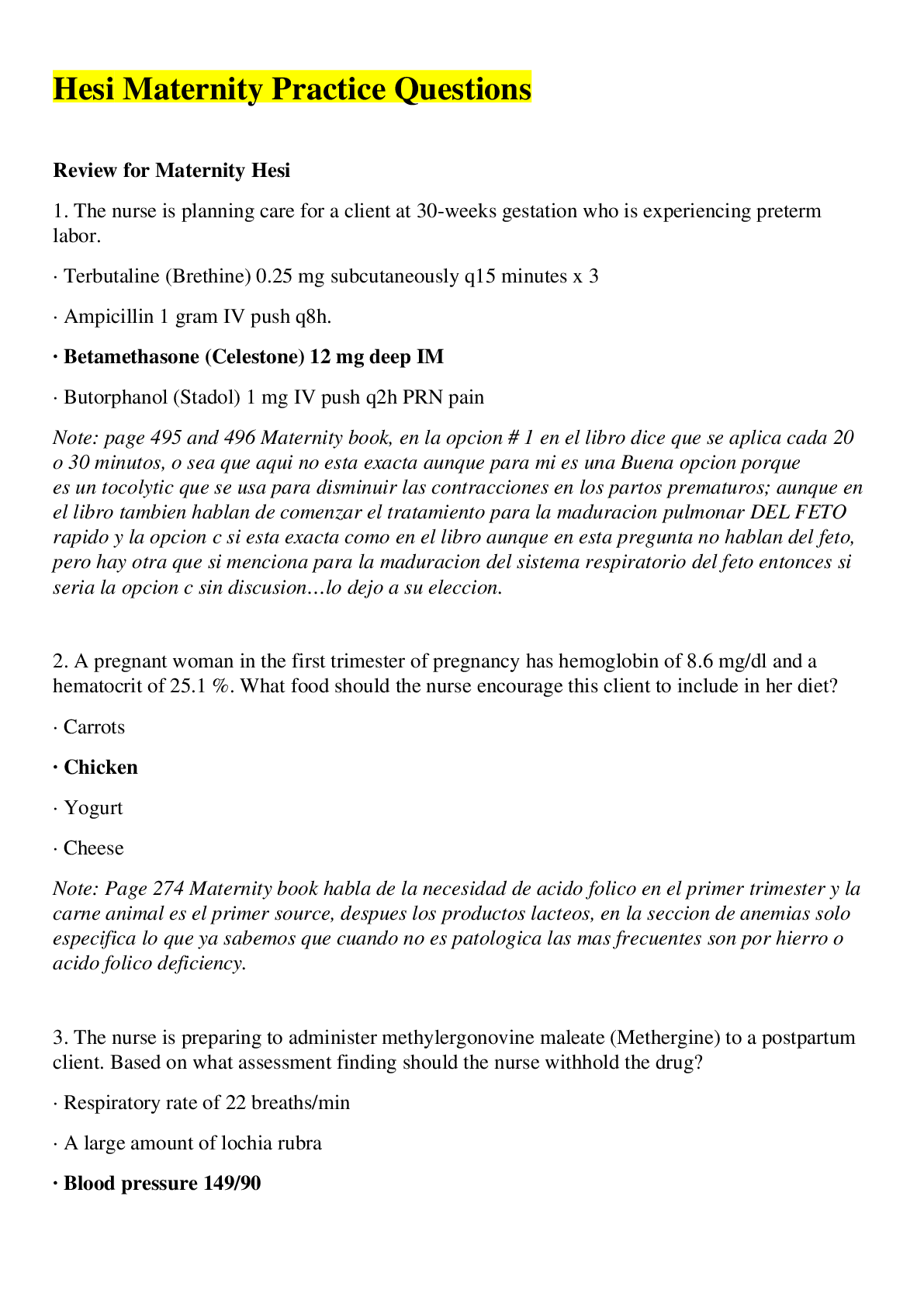
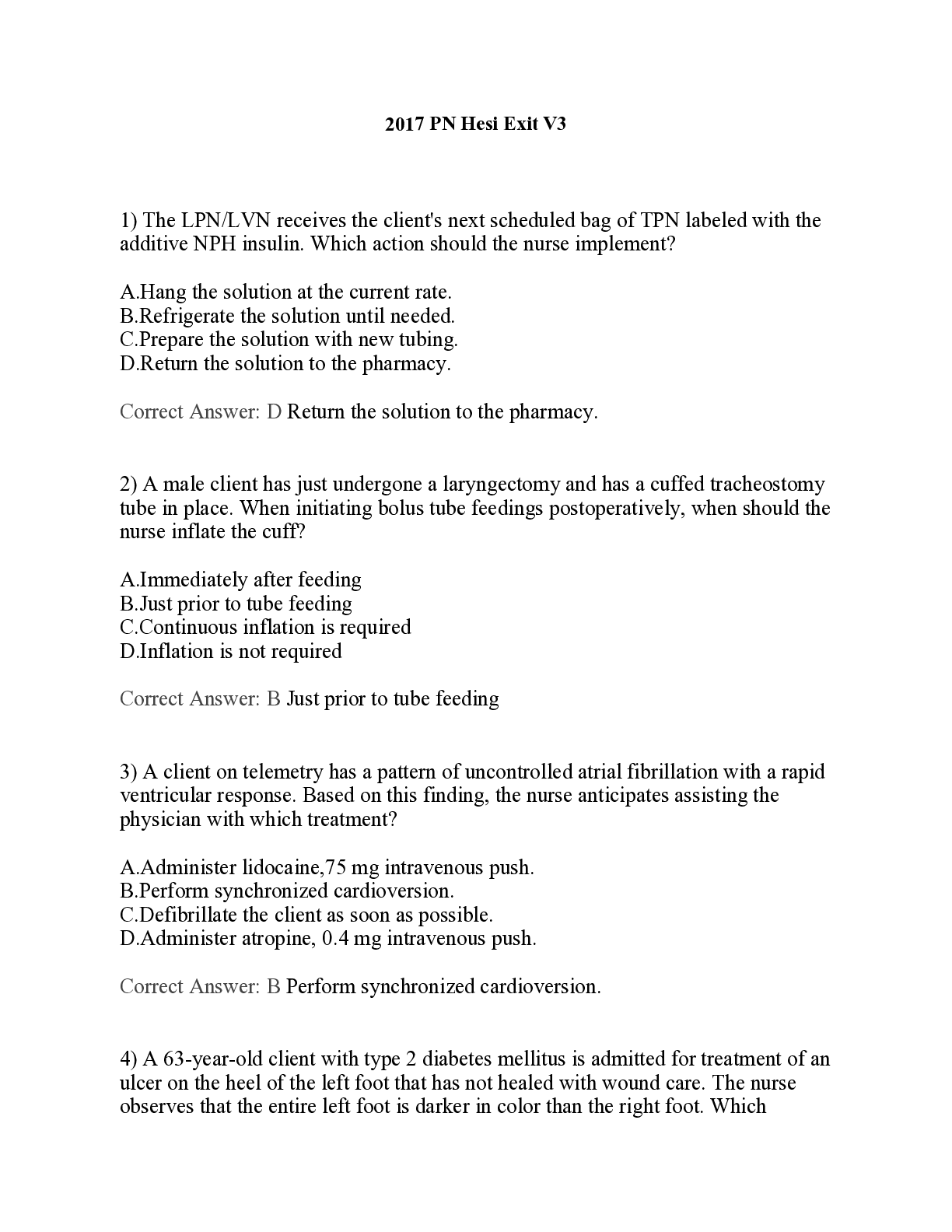
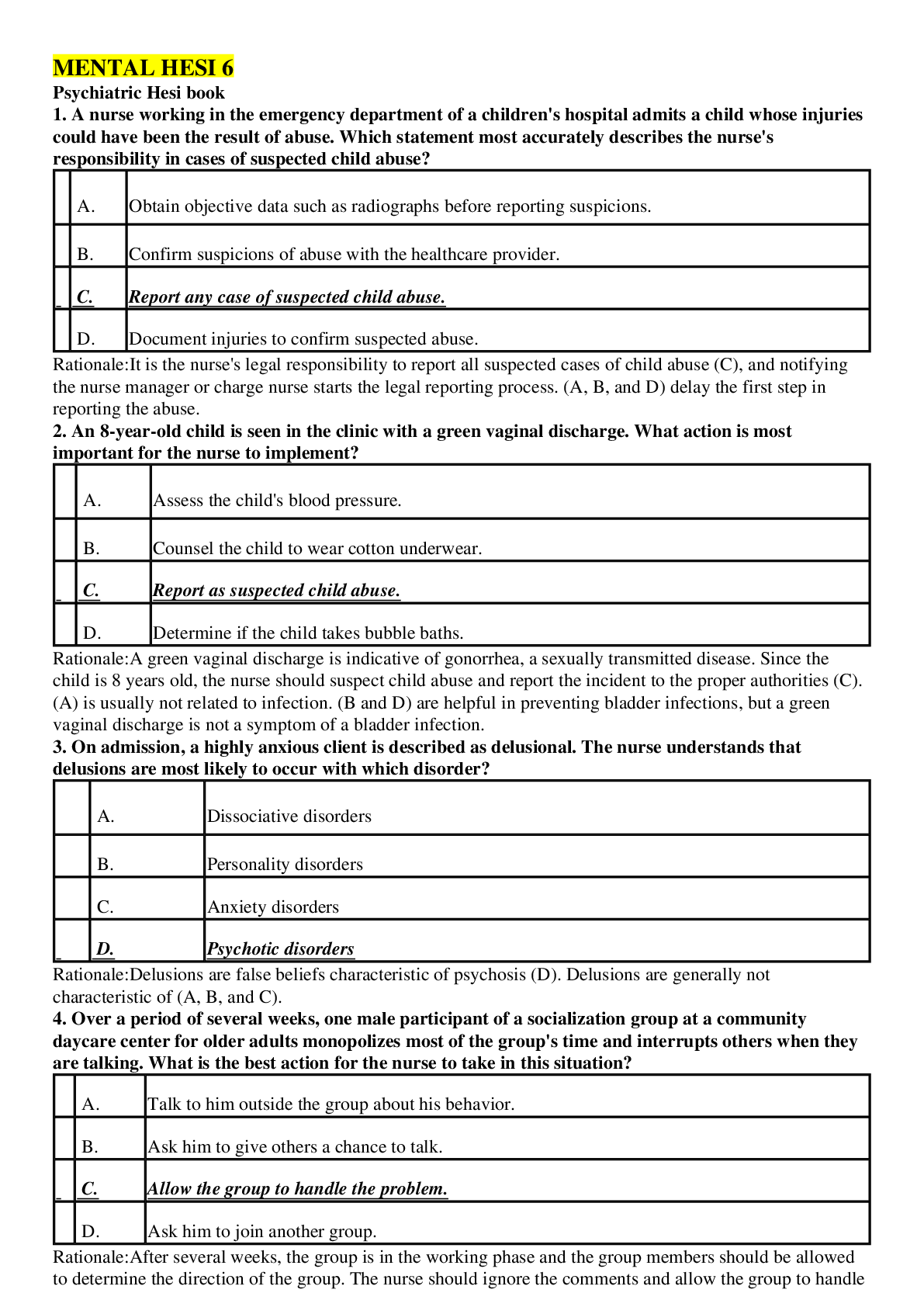
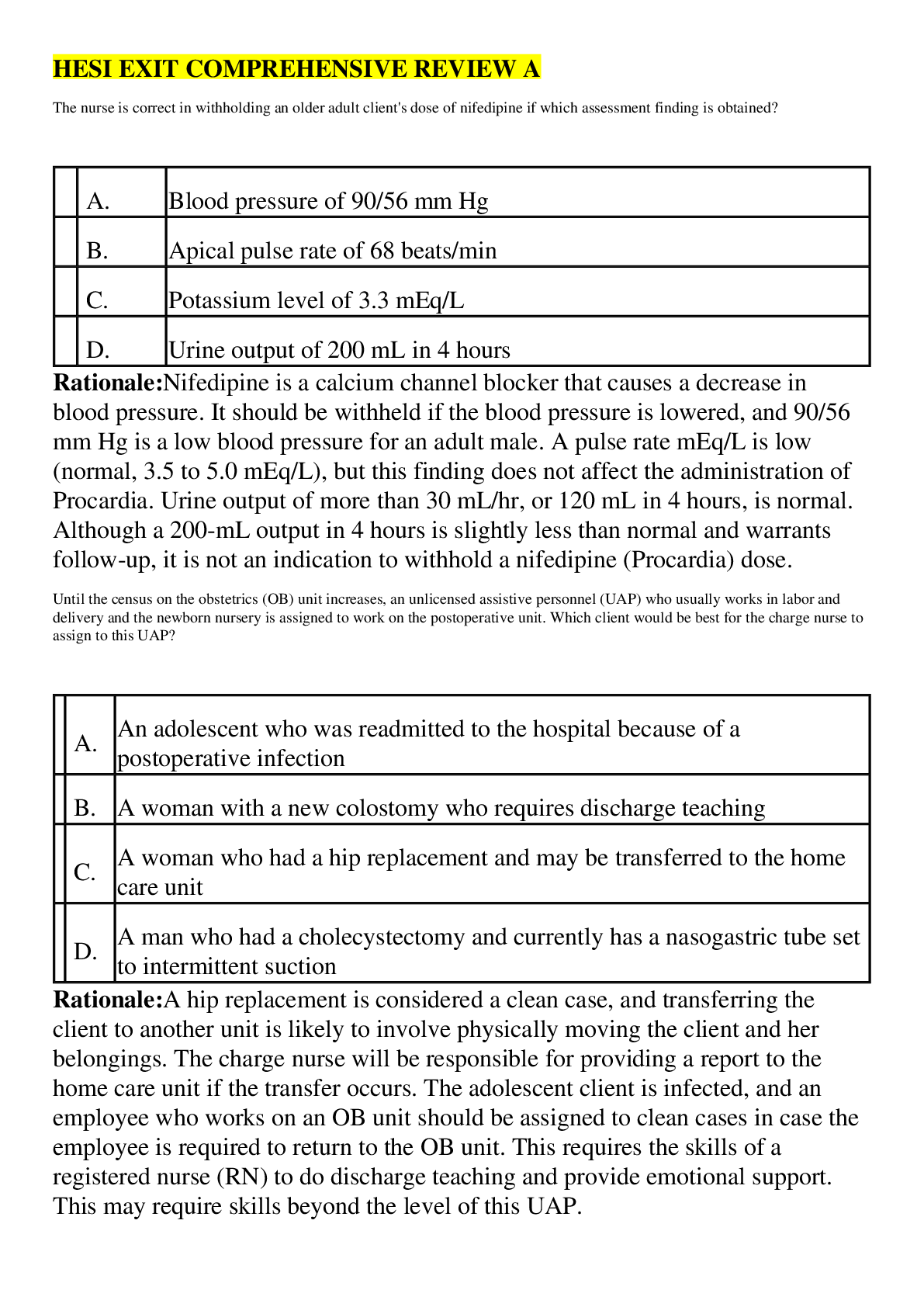
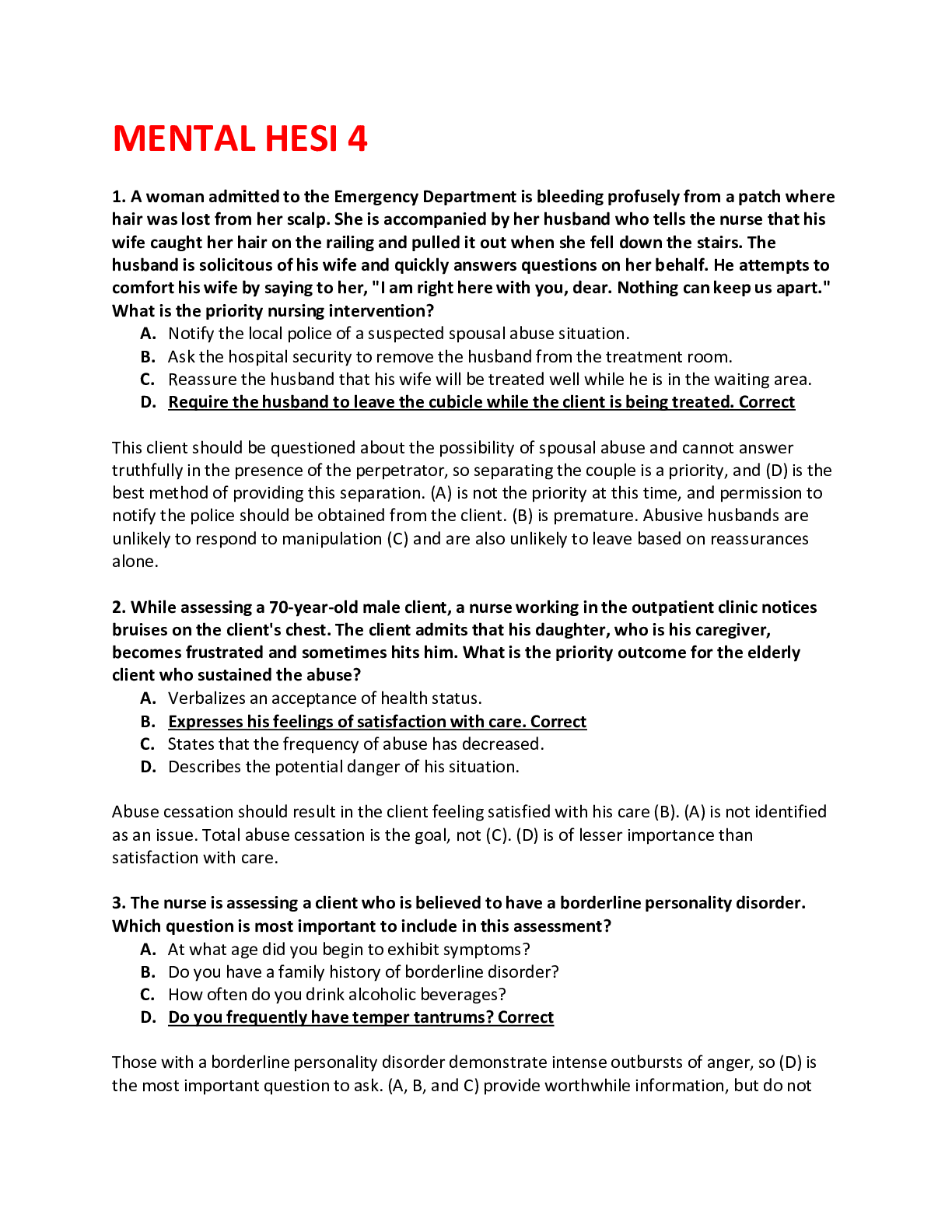
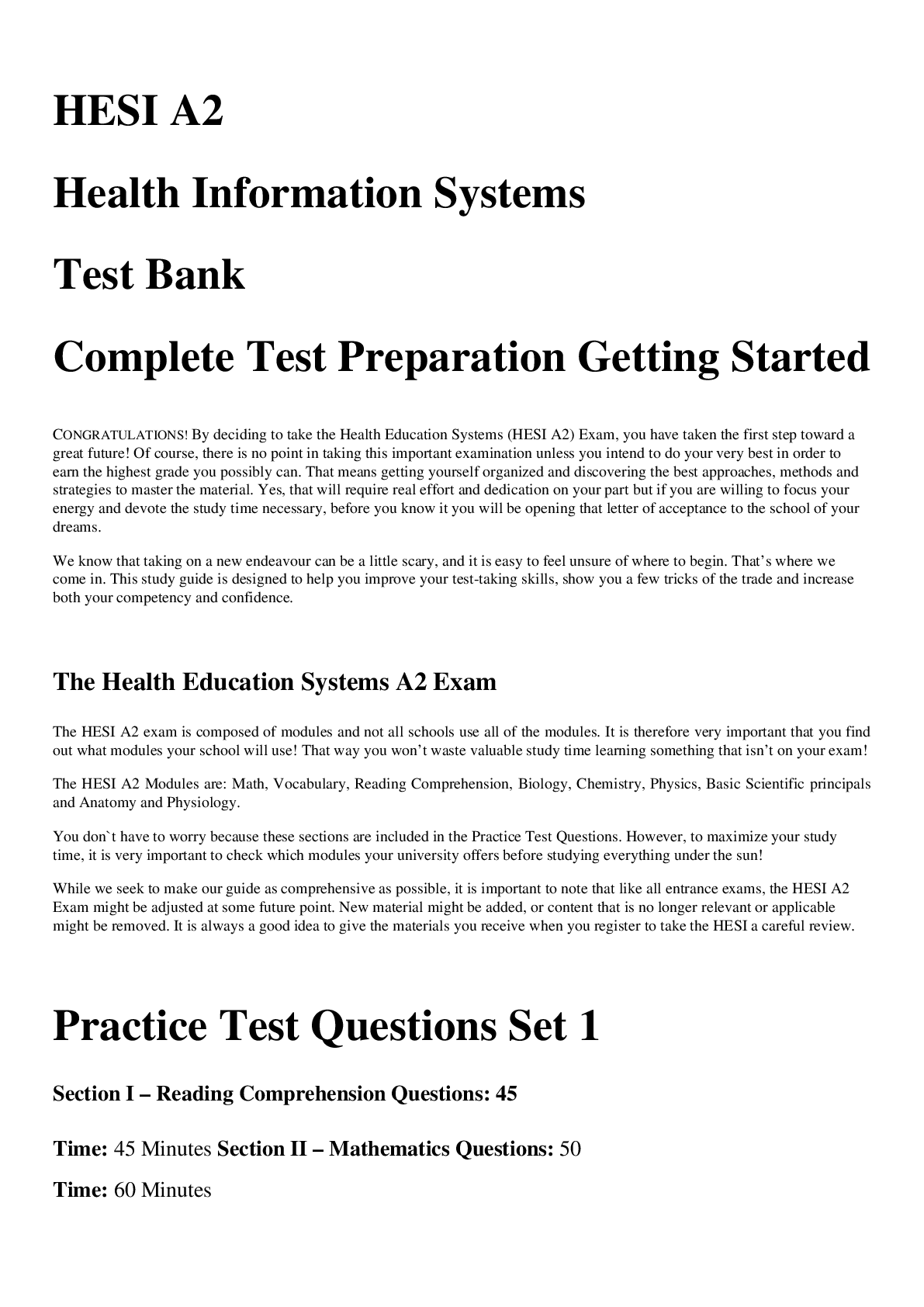
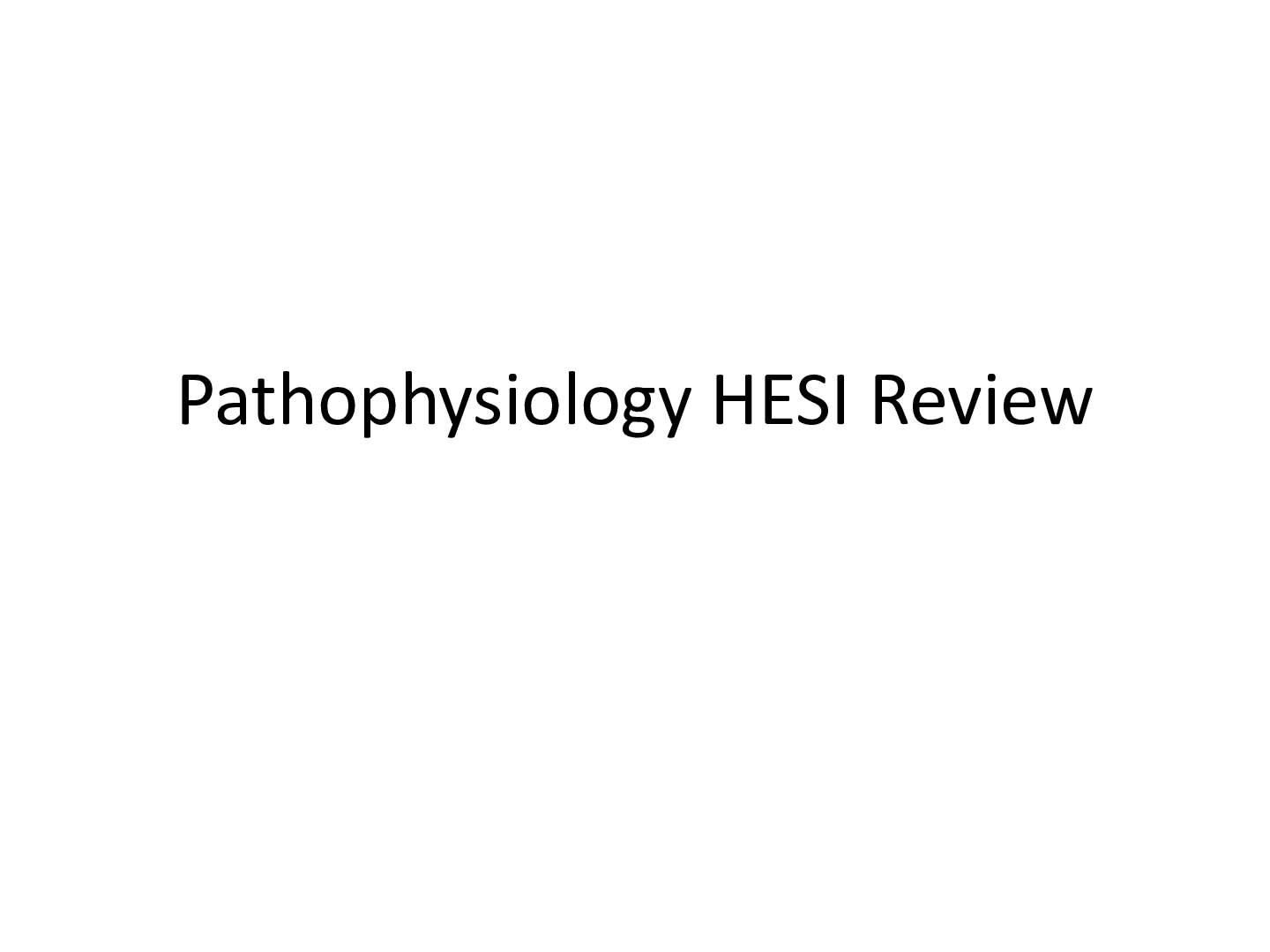
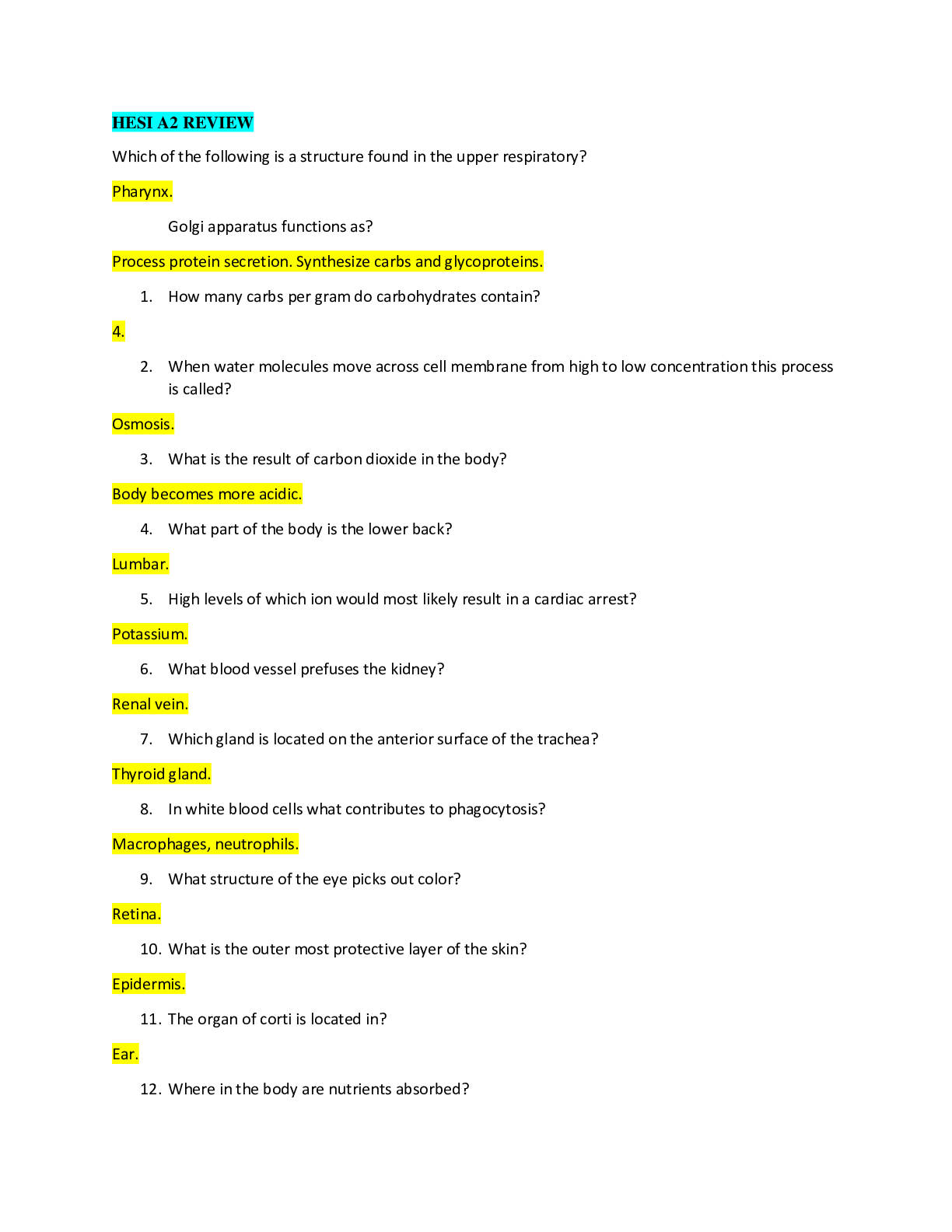
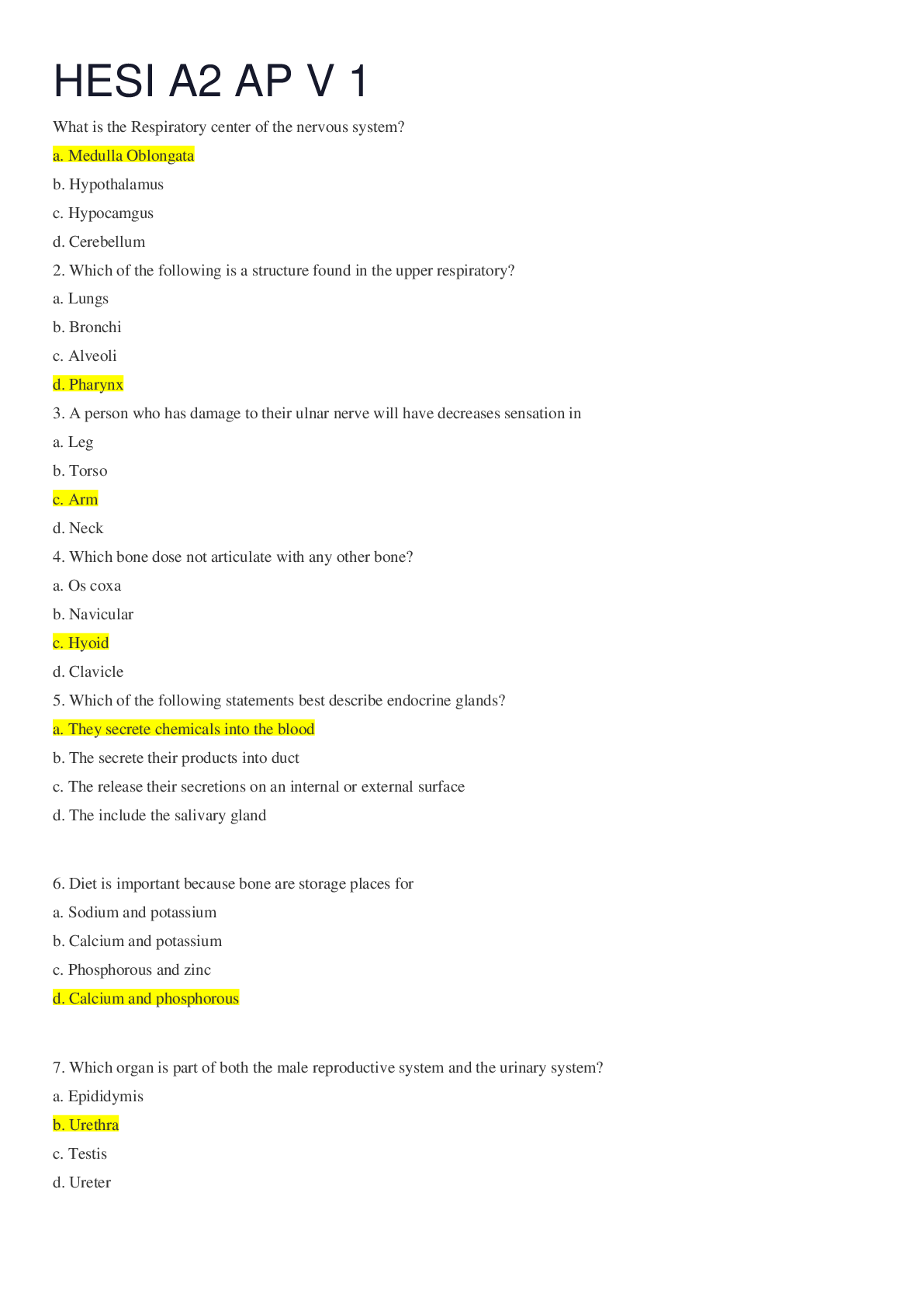

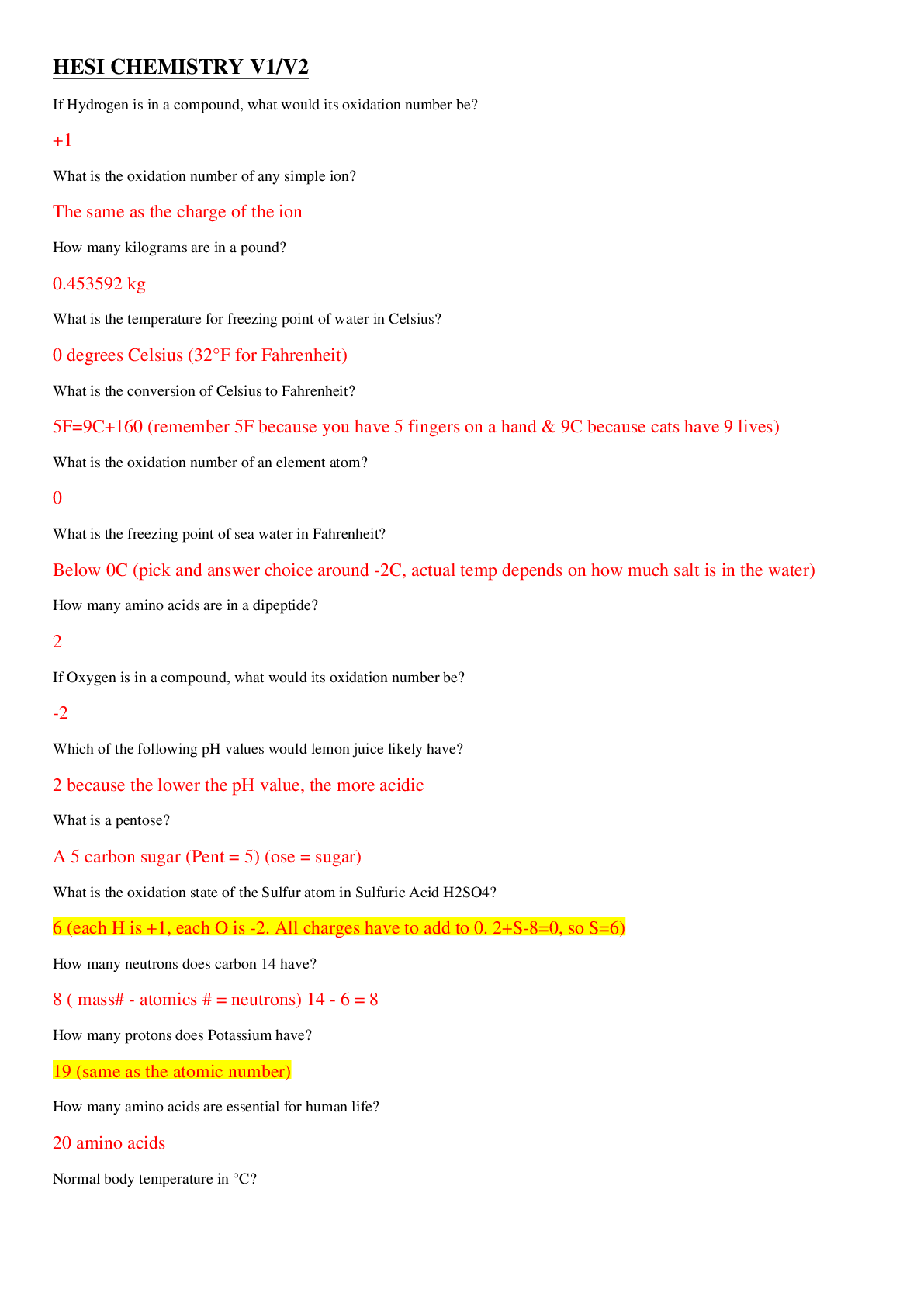


 Practice Test 2022.png)


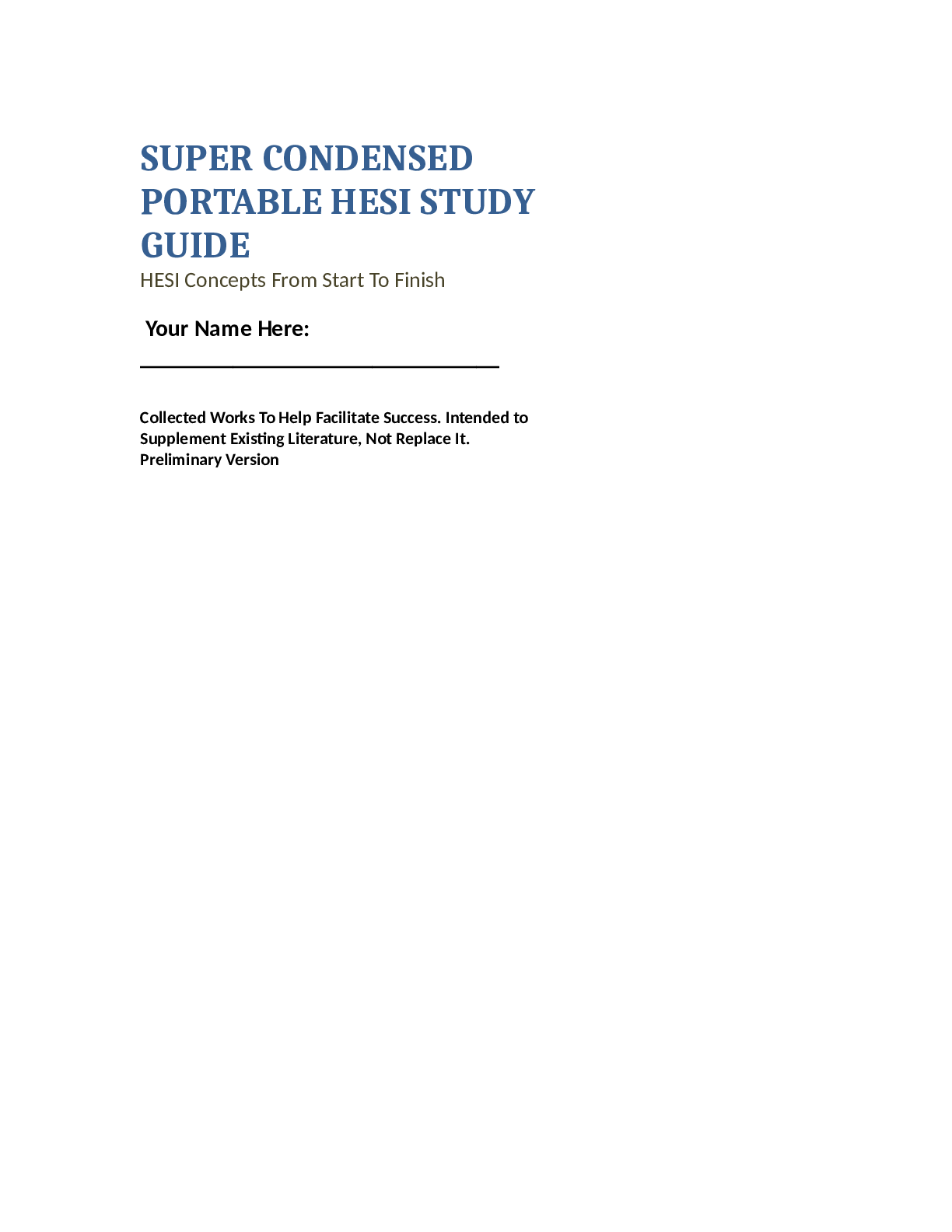




 (1).png)



